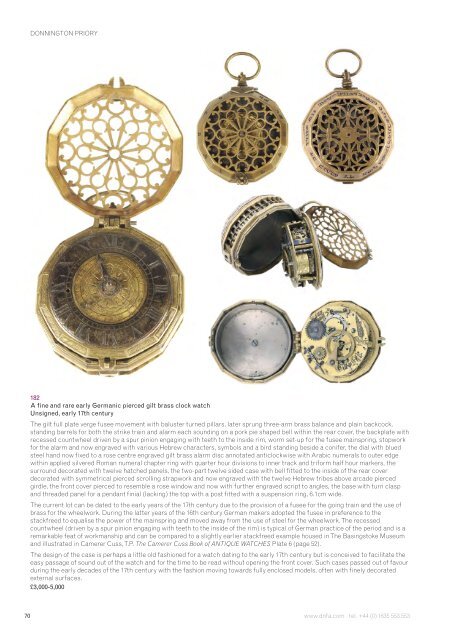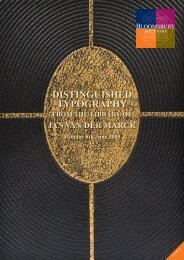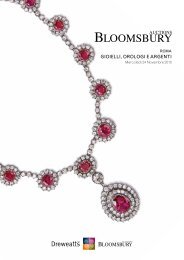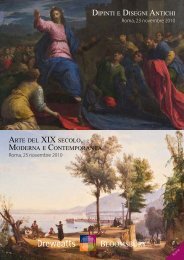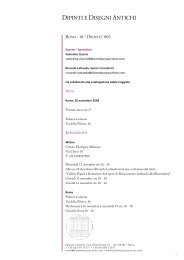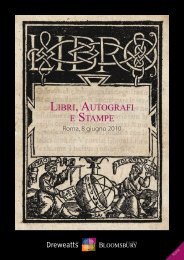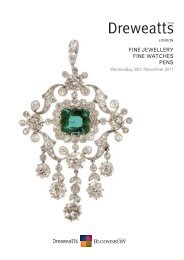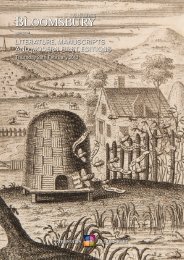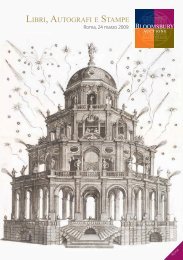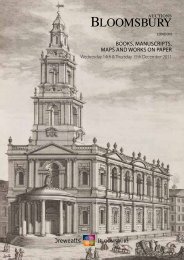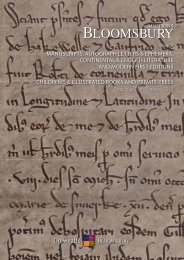PDF Download - Bloomsbury Auctions
PDF Download - Bloomsbury Auctions
PDF Download - Bloomsbury Auctions
Create successful ePaper yourself
Turn your PDF publications into a flip-book with our unique Google optimized e-Paper software.
DONNINGTON PRIORY<br />
182<br />
A fine and rare early Germanic pierced gilt brass clock watch<br />
Unsigned, early 17th century<br />
The gilt full plate verge fusee movement with baluster turned pillars, later sprung three-arm brass balance and plain backcock,<br />
standing barrels for both the strike train and alarm each sounding on a pork pie shaped bell within the rear cover, the backplate with<br />
recessed countwheel driven by a spur pinion engaging with teeth to the inside rim, worm set-up for the fusee mainspring, stopwork<br />
for the alarm and now engraved with various Hebrew characters, symbols and a bird standing beside a conifer, the dial with blued<br />
steel hand now fixed to a rose centre engraved gilt brass alarm disc annotated anticlockwise with Arabic numerals to outer edge<br />
within applied silvered Roman numeral chapter ring with quarter hour divisions to inner track and triform half hour markers, the<br />
surround decorated with twelve hatched panels, the two-part twelve sided case with bell fitted to the inside of the rear cover<br />
decorated with symmetrical pierced scrolling strapwork and now engraved with the twelve Hebrew tribes above arcade pierced<br />
girdle, the front cover pierced to resemble a rose window and now with further engraved script to angles, the base with turn clasp<br />
and threaded panel for a pendant finial (lacking) the top with a post fitted with a suspension ring, 6.1cm wide.<br />
The current lot can be dated to the early years of the 17th century due to the provision of a fusee for the going train and the use of<br />
brass for the wheelwork. During the latter years of the 16th century German makers adopted the fusee in preference to the<br />
stackfreed to equalise the power of the mainspring and moved away from the use of steel for the wheelwork. The recessed<br />
countwheel (driven by a spur pinion engaging with teeth to the inside of the rim) is typical of German practice of the period and is a<br />
remarkable feat of workmanship and can be compared to a slightly earlier stackfreed example housed in The Basingstoke Museum<br />
and illustrated in Camerer Cuss, T.P. The Camerer Cuss Book of ANTIQUE WATCHES Plate 6 (page 52).<br />
The design of the case is perhaps a little old fashioned for a watch dating to the early 17th century but is conceived to facilitate the<br />
easy passage of sound out of the watch and for the time to be read without opening the front cover. Such cases passed out of favour<br />
during the early decades of the 17th century with the fashion moving towards fully enclosed models, often with finely decorated<br />
external surfaces.<br />
£3,000-5,000<br />
70 www.dnfa.com tel. +44 (0) 1635 553 553


